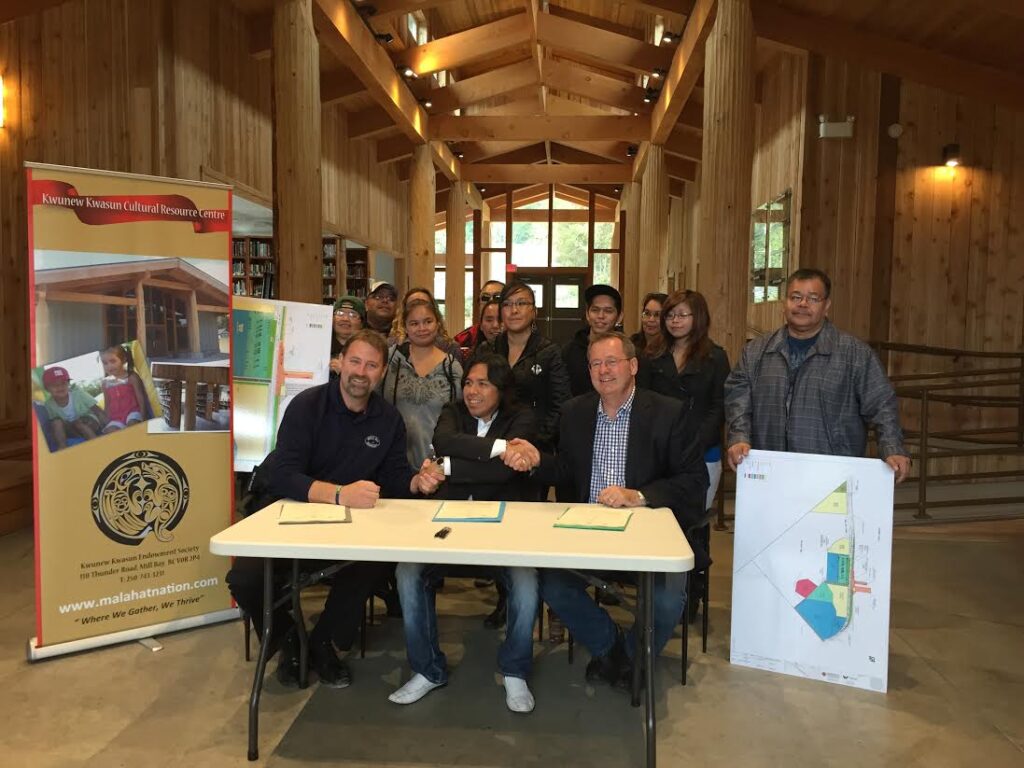The primary community land base of the Malahat Nation, 590 acres of reserve land, is essential to the holistic health, wellbeing, and culture of the community. To support the economic needs of the community, the Nation has decided to utilize some parcels of this land for developmental purposes. Recognizing the potential impacts that could result, the community began to explore ways to protect the land so that development would have no negative impact on their culture and traditions.
Ground-truthing is a process where the contents of a satellite image are compared to surface observations. People make surface observations by walking through the area identified in the satellite images and take notes about the features of the environment. The Malahat Nation decided to embark on a ground-truthing initiative, led by Elders and youth in collaboration with the University of Victoria (UVic). This partnership allowed for the stimulation of intergenerational relationships knowledge exchange, and knowledge exchange resulting in a shared understanding of the importance of specific plants for traditional uses, such as food and medicine. This helped the Malahat Nation decide which land could be developed and which land should be conserved. Not only did this process help guide land-use decisions, but it also helped to strengthen cultural ties to sustain it across generations.
Partnerships & Stakeholders
- Malahat Nation
- Malahat Nation Elders, youth, and families
- UVic Community Mapping Collaboratory (Department of Geography)
- Capital Regional District
- H’ulh-etun Health Society
- Te’mexw Treaty Association
Summary of the Process
In 2013, the Malahat Nation received a PlanH Capacity Building Grant to support their goal of zero negative impact on culture in any development activities pursued. To inform the land-use planning process, three methods were prioritized: archival research on traditional lands, ground-truthing, and community mapping workshops. For these activities to be successful, a trusting relationship needed to be established with the Elders who had agreed to participate. Although some Elders expressed concern for sharing information, the community sessions facilitated by the UVic staff and students helped to foster an honest partnership. The Elders possess a wealth of knowledge and wisdom, and were the key advisors in this project.
Once a trusting partnership was established, ground-truthing activities took place. Three site visits were made to Malahat Lands to identify traditional plants and to engage in activities such as observing an overall growth of a cedar tree. Elders shared their knowledge with youth and Malahat Nation staff, which enabled them to gain an understanding of the importance of these plants to the vitality of Malahat culture. The youth that participated in the activity found this to be an especially valuable experience and described it as being a cool way to revitalize cultural knowledge. Community mapping workshops and interviews with community members also allowed people to further connect and share intergenerational knowledge about the historical uses of native plants.
To ensure that ground-truthing and mapping activities could be implemented by the Nation’s government in the future, four training sessions were held with UVic facilitators. This allowed Malahat Nation staff to acquire the appropriate technical skills needed to continue with this work.
Not only has this information been used for the land-use planning process, but other partnerships have been strengthened, as well. For example, this knowledge helped the Hulhetun Health Society to re‐introduce the use of traditional foods and medicines to Malahat Nation community members, while the Te’mexw Treaty Association shared research regarding traditional foods and medicine for cultural and traditional uses.
Overall, this project has helped to enhance Malahat members’ understanding of traditional plants, medicines and natural resources, such as harvesting Stinging Nettle and Devil’s Club Root, and they are keen to learn more. This information has proven to be extremely useful for the land-use planning process to ensure that future developments give the highest regard for cultural sites and community well-being.
Outcomes & Impact
- Knowledge exchange and learning activities have stimulated the development of intergenerational relationships between Elders and youth.
- Collaboration with UVic has improved the Malahat Nation’s knowledge of mapping methods and tools to produce quality, sharable information using Google Earth.
- All of these activities have enhanced the skills and leadership capacities to help the Nation’s government to develop a healthier community.
- There is a greater understanding of the culture and the land, which will be incorporated into land-use plans and policies.
For additional information, please contact:
Robert Sagmeister
Director, Community and Governance
Malahat Nation
T: 250-743-3231
E: robert.sagmeister@malahatnation.com




